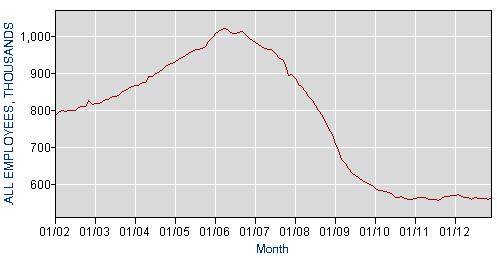January 05, 2013
The Washington Post rightly noted the increase of 30,000 jobs in the construction industry as one of the bright spots in the December jobs report. As the piece points out, construction was one of the largest sources of job loss in the downturn and presumably a substantial portion of the job growth in the recovery will also be construction.
However the link between construction employment and actual construction is not nearly as close as would be expected. Housing starts peaked at just under 2.1 million in 2005, just before the top of the bubble. By the beginning of 2007, starts had dropped by close to one-third to just 1.4 million at an annual rate. Yet construction employment had barely changed over this period. Similarly, since 2010 housing starts have increased by more than 20 percent, yet employment has been virtually flat.
Residential specialty trade contractors

Source: Bureau of Labor Statistics.
Residential building

Source: Bureau of Labor Statistics.
This pattern can be explained by the fact that many of the workers in the residential construction sector are undocumented workers who are likely not showing up on employers’ payrolls. This could explain why there was a large drop in housing starts as the bubble driven construction boom began to fade in 2006 and 2007, with no corresponding decline in employment. It would also explain why the uptick in housing starts the last two years has not led to any substantial increase in the number of construction jobs reported in the establishment survey. Essentially the data in the establishment survey are only giving us part of the employment picture in the residential construction sector.







Comments